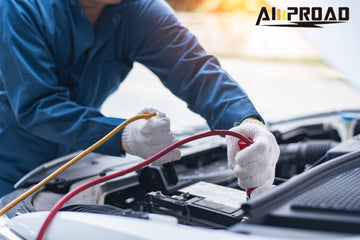
In today's world, where life often revolves around automobiles, being stranded due to a dead car battery can be a significant inconvenience. Emergency starting power supplies, commonly known as jump starters or portable power banks, have emerged as indispensable tools for vehicle owners, offering a reliable solution to jump start their cars in such situations. However, with the multitude of options available in the market, choosing the right emergency starting power supply can be a daunting task. To ensure you make an informed decision, it's crucial to understand the essential factors to consider before making a purchase.
Battery Capacity
Battery capacity is one of the most critical factors to consider when purchasing an emergency starting power supply. It determines the device's ability to provide sufficient power to start your vehicle's engine. Generally, a capacity of around 10,000mAh is considered adequate for regular-sized cars. However, if you plan to use the power supply as a portable charger for other electronic devices, such as smartphones or laptops, you may want to opt for a higher capacity to meet your diverse needs.
Peak Current and Starting Current
The primary function of an emergency starting power supply is to deliver a significant amount of electricity instantly to activate your vehicle's battery. The peak current and starting current are crucial specifications that determine the power supply's ability to provide the necessary burst of energy required to crank the engine. Most small cars are equipped with a 60AH battery, and the starting current typically falls within the range of 100 to 300 amps. However, larger engine displacements may require higher starting currents. Some power supplies also offer a "0 voltage" start function, which can be beneficial if your vehicle's battery is completely drained. For example, the AMPROAD jump starter offers an impressive 2000A start current and 4000A peak current, making it suitable for jump starting even heavy-duty trucks or vehicles with larger batteries. Some power supplies also offer a "0 voltage" start function, which can be beneficial if your vehicle's battery is completely drained.
Output Voltage and Interfaces
When selecting an emergency starting power supply, consider the output voltage and interfaces it offers. Common output voltages include 5V, 9V, and 12V DC. The more diverse the interfaces, such as USB, Type-C, and DC ports, the more versatile the power supply becomes, allowing you to charge various electronic devices, including mobile phones, laptops, and even small appliances through an inverter.
Cycle Life
The cycle life of an emergency starting power supply refers to the number of charge-discharge cycles it can withstand before its capacity starts to degrade significantly. While most products are rated for several thousand cycles, regular household use is unlikely to reach this limit. However, it's still a good idea to consider the cycle life when comparing different models, as it can impact the overall lifespan of the device.
Lighting Function

Having a lighting function on an emergency starting power supply can be incredibly useful, especially in dim or nighttime conditions. Models with built-in LED lights or spotlights can illuminate the area around your vehicle, making it easier to connect the jumper cables or perform other necessary tasks. Additionally, some power supplies feature SOS rescue lights, which can be invaluable in emergency situations.
Battery Clamps and Cables
The quality of the battery clamps and cables is another crucial aspect to consider. Opt for power supplies with thick copper clamps and soft silicone-insulated wires that can handle high currents and temperatures. The wire length should also be long enough to accommodate vehicles with larger battery placements or those with batteries located in hard-to-reach areas.
Safety Features
Safety should be a top priority when using an emergency starting power supply. Look for models that offer comprehensive protection features, such as over-discharge, reverse charge, over-current, short circuit, reverse connection, over-temperature, over-voltage, and over-charge protection. Some models emit a warning beep or light if the connections are reversed, preventing damage to both the vehicle and the power supply. Anti-reverse interface designs can also be beneficial, especially for novice users.
Operating Temperature
Depending on the climate you live in, the operating temperature range of the emergency starting power supply can be an essential consideration. If you reside in colder regions, pay attention to the discharge temperature rating. For example, a -20°C rating should suffice for most areas in northern climates. Using the power supply within its specified operating temperature range can prolong its lifespan and ensure optimal performance.
Power Display
Since emergency starting power supplies are typically used infrequently, there may be some power loss during long periods of inactivity. A reliable power display or operational interface can help you monitor the remaining battery power accurately. While LCD digital displays may seem more advanced, they may not necessarily be more reliable than simple power level indicators, especially in low-temperature environments.
Brand Reputation and Certifications
When purchasing an emergency starting power supply, it's essential to choose a reputable brand with quality certifications and test reports. Different companies use varying molds, chip solutions, battery structures, and functional features, which can impact the overall quality and performance of the product. Additionally, some brands may command a premium due to their reputation and customer service.
Price and Value
Emergency starting power supplies are available at various price points, ranging from budget-friendly options to high-end models with advanced features. While it's tempting to opt for the most affordable option, it's crucial to strike a balance between cost and quality. Consider your specific needs and prioritize features that are most important to you. A higher price tag may be justified if the power supply offers superior performance, durability, and additional useful features.
Additional Features
Depending on your needs and preferences, you may want to consider emergency starting power supplies with additional features. For example, waterproof sealing caps can protect the device from moisture and ensure its longevity. Some models come equipped with compasses, which can be handy in case you find yourself stranded in an unfamiliar area. Longer battery cables can also be advantageous if you need to reach batteries located in hard-to-access areas.
In closing, choosing the right emergency starting power supply can be a game-changer for vehicle owners. By considering factors such as battery capacity, peak current, output voltage, interfaces, cycle life, lighting function, battery clamps and cables, safety features, operating temperature, power display, brand reputation, price, and additional features, you can ensure that you make an informed decision and invest in a reliable and versatile power supply that suits your specific needs. Remember, being prepared with the right emergency starting power supply and knowing how to boost a car can save you from the inconvenience and stress of being stranded with a dead battery, allowing you to get back on the road quickly and safely.


